El Centro History Home // History 1301 // History 1302 // Mexico // African Americans // American Indians

The period from 1865 to 1877 is called Reconstruction to reconstruct the Union after the Civil War. I want you to be able to evaluate its success. To do that, we need to know what the purposes of Reconstruction were. Now we cannot create things we wish they had tried to do, we just have to evaluate what they intended to and whether or not Reconstruction was successful. There were three purposes of Reconstruction as far as northerners and Republicans believed. First, they wanted to reunite the U.S. physically and psychologically and bring the Confederate States back into the Union. Second, they wanted to rebuild the southern economy without slavery. And third, they wanted a period of transition for freed slaves which was a result of the 13th Amendment that went into effect in late 1865. This amendment freed all slaves and ended indentured servants throughout the U.S.
While most agreed on the purposes of Reconstruction, few agreed on how to accomplish the goals. As a result Reconstruction goes through three phases with leadership changes.


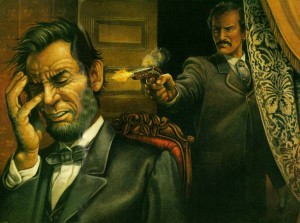

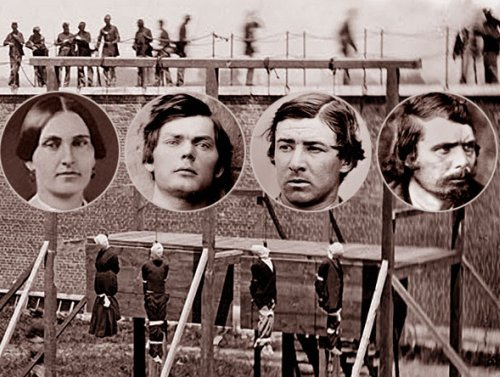
Lincoln had established his plan before his assassination called the Ten Percent Plan that required 10% of southern voters to swear loyalty to the Union but he provided no protections for ex-slaves. Lincoln's own party, the Republicans, tried to strengthen the paln with the Wade-Davis Bill that required a majority of southern voters pledged their loyalty to the Union and demanded guarantees on equal rights under the law for African-Americans. Lincoln refused to sign it using the "pocket veto."
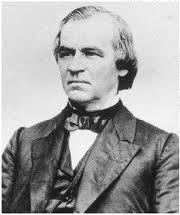
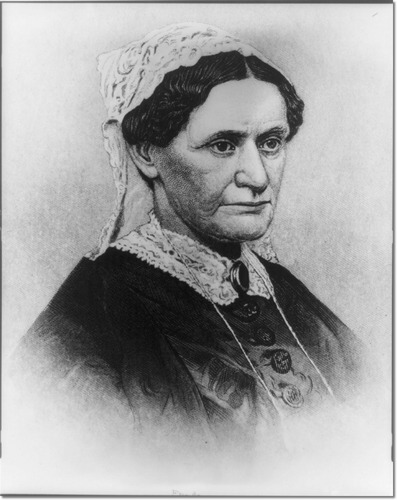
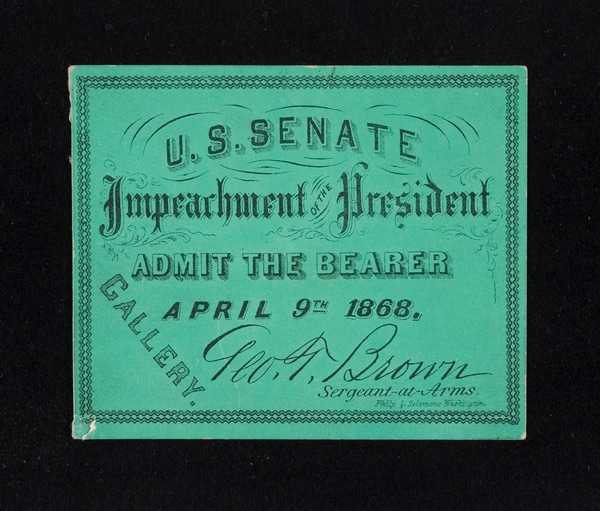
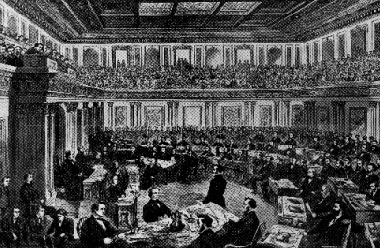
After Lincoln's assassination, nine days after the war officially ended, Andrew Johnson, a Democrat, became President. Lincoln had put a Democrat on his ticket to draw votes. Johnson was against slavery but his leadership was good news for southern whites. His phase of Reconstruction was called Presidential Reconstruction and the rules changed.

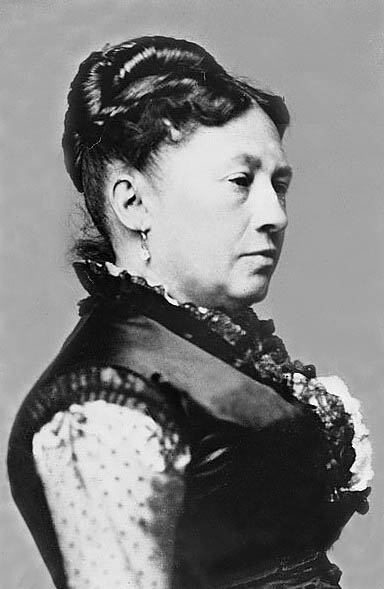
Then in 1868, a Republican and Civil War hero, Ulysses S. Grant was elected. This period of Reconstruction was known as Congressional Reconstruction because Congress basically took over guiding the nation through Reconstruction.

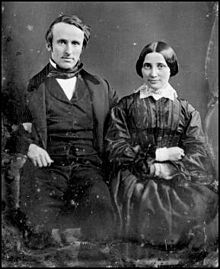
After 1870, however, the North began to loose interest and ex-Confederates had taken control of southern governments so in 1877, the next President, Rutherford B. Hayes officially ended Reconstruction.
Through it all, ex-slaves had aspiration, goals, disappointments, and successes. The main help came from the Freedmen's Bureau created in March, 1865. The Bureau provided a variety of services to both ex-slaves and displaced whites. The biggest success for African-Americans was education. They created 3,000 schools and 13 colleges. From 1860 to 1880, over 1,000 African-Americans graduated from college. After the Bureau folded in 1872, education became less accessible, though.
Any success by African-Americans was viewed with suspicion among many southern whites. They saw a threat to their culture and reacted like most people do when they loose something, grief. All the stages of grief could be found among southern whites. Some were in denial and immigrated to places that still had slaves especially Brazil Others were into bargaining, "oh, God, please let the 'Old South' return and I'll be good." Other whites suffered from depression and some even committed suicide rather than facing the new reality. Some whites, though, managed to make it to acceptance and tried to cooperate. They were labeled "scalawags" or traitors by many southern whites. The most common response, however, was anger. Listen to the song "I'm a Good Old Rebel" (links at the top of this page) and you get a feel for the anger most southern whites felt. As you listen make a list of the things the "Old Rebel" hates.
Under these conditions, Reconstruction proceeded and ex-slaves were expected to transition to freedom. At first, their reactions varied like southern whites did. Some like Booker T. Washington's family said it was sad to say good-bye to former owners and friends at the only home they knew. Some refused to leave the plantations if they had decent former owners hoping they would be employers and the elderly had little choice. At the other extreme, some advocated "black nationalism" or the belief that all Africans should live together and govern themselves. Some immigrated to Africa especially Liberia. But the dominant view of African-Americans at the beginning of Reconstruction as expressed by Frederick Douglass wanted equal opportunity. They just wanted to be left alone to pursue their own dreams and aspirations.
At first former slaves just experienced freedom and explored its boundaries. How free were they? They held celebrations and parades referring to 1865 as the "Year of Jubilee." They changed their names. They traveled despite being attacked sometimes to search for relatives. And, many moved to cities where there was more of a sense of freedom. They also began to alter behavior toward whites such as refusing to refer them by first names required as slaves. They refused to yield on the sidewalk as previously required. They acquired previously banned possessions including guns and dogs. Women began change the way they dressed replacing the kerchief with hats. They also refused to do "live-in" work while married women sought homemaker status rather than laborer.
All of this was seen as insolence by most southern whites. Resentment grew. African-Americans met this resentment with crating a sort of parallel society, not quite "black nationalism" but not integration either. They founded their own newspapers, organizations, schools, and churches. But, there were conflicts within the African-American community mainly between the formerly free and ex-slaves. The formerly free African-Americans enjoyed special status before the Civil War and assumed as in other slaves nations their importance would grow especially those of mixed racial backgrounds. Their priorities were equal rights, integration, and the right to vote. Ex-slaves wanted land.
To most ex-slaves freedom meant land. It meant independence, escape from white supervision and believed they had been promised 40 acres and a mule. The Freedmen's Bureau was authorized to distribute public and confiscated land from Confederate leaders. Plantations were turned over to the ex-slaves as in the case of Jefferson Davis's plantation which became a model community. Others pooled money to buy land. In addition, in 1866, the Southern Homestead Act was passed to provide assistance to prospective landowners. By the late 1870s, 14,000 African-Americans had utilized it.
So, in the beginning, it looked like ex-slaves might do well. Then, big problems began to emerge during the second stage Reconstruction, Presidential Reconstruction. When Andrew Johnson took over, many Republicans were pleased and believed he would be harsher on the South than Lincoln. This seemed to be true at first when Johnson added requirements for southern states to be officially "reconstructed." He disfranchised (too right to vote away) from ex-Confederate leaders unless he pardoned them personally. He required Confederates to repeal secession laws and to "repudiate" or not pay war debts. He also required they ratify the 13th Amendment.
Then, Reconstruction changed again. The reason was Andrew Johnson. One historian described him as "narrow-minded, bull-headed, and tortured by feelings of inferiority." He was also a southern Democrat from Tennessee. He had opposed slavery but not because he loved African-Americans or that slavery was inhumane. He hated the white aristocracy and slaves made it all possible. Had it not been for slaves, there would not have been a white aristocracy or blaming the victim. He said he was a "self-made man." Thaddeus Stevens, a radical Republican responded that Johnson had "relieved God Almighty of an awesome responsibility." Johnson resented the old aristocracy but feared African-American rule of the South and said "white men alone must manage the South."
Johnson will show little sympathy for ex-slaves. He pardoned any ex-Confederate who asked and did whatever white southerners wanted. When states began passing "Black Codes" or "Labor Codes" in Texas, he did nothing. These state laws controlled the African-American work force but gave rights such as marriage. On the other hand, some established penalties for quitting a job, traveling without permission, and vagrancy. Some states made it illegal to sell land to African-Americans while others allowed them to have only certain jobs. Some states required a license to preach and others would not allow them to hunt or fish for fear they might support themselves. In Texas, African-Americans were required to be "obedient and respectful" to whites.
Johnson also chose to do nothing about Jim Crow laws. These were laws that legalized segregation of public facilities. When white southerners asked for African-American soldiers to be removed from the South, Johnson complied. Then, when they said they wanted their land back, Johnson ordered the removal of ex-slaves and returned the land to the original owners. With all this, white southerners began to feel more optimistic.
Meanwhile, African-Americans struggled to survive. Most ex-slaves ended up as sharecroppers, a agricultural system in which the farmers do not own the land and pay rent with their produce. They did escape white supervision, but the had to deal with the crop-lien system, a credit system with store owners and other businesses in which they paid their debts with future crops. Ex-slaves called the storekeeper the new master. By the end of the harvest, the sharecroppers had little or nothing left for self-survival and were trapped in poverty.
Meanwhile, Johnson declared Reconstruction over and a success. Many Republicans objected. They pointed out that the same old leaders were back in power in the South. Ex-slaves were being terrorized, impoverished, had no legal rights, and the court system was biased. So, in late 1866, Congress began to take actions. They refused to seat representatives elected from the South including Pinckney Pinchback, a mulatto Senator from Louisiana. They also passed the Civil Rights of 1866, the first civil rights act in U.S. history. This was an effort to destroy the Black Codes and gave all citizens equal protection under the law. Johnson vetoed the bill and the continuation of the Freedmen's Bureau. So, for the first time in U.S. history, Congress overrode the president's veto to make it a law.
Fearing what future congresses might do, the Civil Rights Act needed to be as permanent as possible, a constitutional amendment. It became the 14th Amendment. It gave rights of citizenship to all born in the U.S. or naturalized citizens except American Indians who were not considered citizens at this time. The amendment also penalized states that did not allow African-American men to vote. This was the first time gender had been mentioned in the Constitution so this will leave women out in the cold. The amendment also barred ex-Confederate leaders from office.
This became the major issue of the Congressional election of 1866. Johnson actively campaigned against it. Feminists opposed it for introducing gender in terms of rights. Some African-Americans opposed it because it stopped short of guaranteeing the right to vote. At any rate, Republicans who supported it were swept into office taking 2/3 majorities in both houses and becoming veto-proof. One of the reasons for this overwhelming victory was the increasing violence in the South. Riots erupted throughout 1866. In Memphis, 48 were killed, all but 2 of them African-Americans. In New Orleans, 34 African-Americans were killed along with three scalawags when the police joined the rioters.
With the resounding victory, though, Congress takes over Reconstruction and the period of Congressional Reconstruction began (also known as Radical or Military Reconstruction). This will continue until 1877. Congressional Reconstruction did not include Tennessee because that state had ratified the 14th Amendment and there had always been a strong anti-Civil War population. The other ten states received new orders.
The South was divided into five military districts. States were required to rewrite the state constitutions giving African-American men the right to vote. They required the constitutions required a majority of voters approve them. They also required ratification of the 14th Amendment, gave the military the authority to register voters and supervise elections. Congress also made it easier for African-Americans to take cases to court, abolished peonage (holding a person to labor util debts are paid), but there was still no economic help and no support of the vote for African-Americans outside the South. While they were at it, Congress decided to impeach Andrew Johnson for ignoring the Tenure of Office Act. This law stated a President could not remove certain officials without Congressional approval. Johnson removed one of the covered officials so was impeached. He was acquitted by one vote and, therefore, not removed from office.
With all this the reactions to Reconstruction changed. African-Americans were more optimistic but ex-Confederates were dismayed. Some of the most dramatic changes came as a result of the new state constitutions. African-Americans were included as delegates to the conventions and they write the most liberal constitutions in the South's history. They established public schools, compulsory education in Texas, orphanages, relief for the poor, abolished the whip for punishment, eliminated property requirements to vote, nine states recognized property rights for married women, Texas made free land available, two states (S.C. and LA) outlawed segregation, and some American Indians like the Seminole in Florida given rights.
As a result more African-Americans were elected to office including seven to the U.S. House and two U.S. Senators. At the same time, they faced enormous problems. Illiteracy was declining but still betwee 70-80%. Jim Crow laws were still in place. There was little upward mobility and obstacles to voting. As the Democrats made big gains in the South, the vehemently opposed the Freedmen's Bureau and the vote for African-Americans. Increasing violence brought about a new threat, organized terrorism from organizations like the Ku Klux Klan.
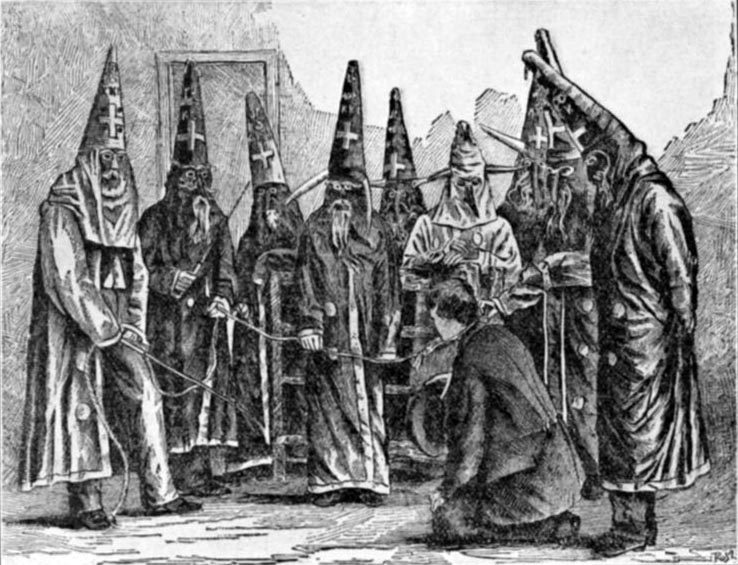
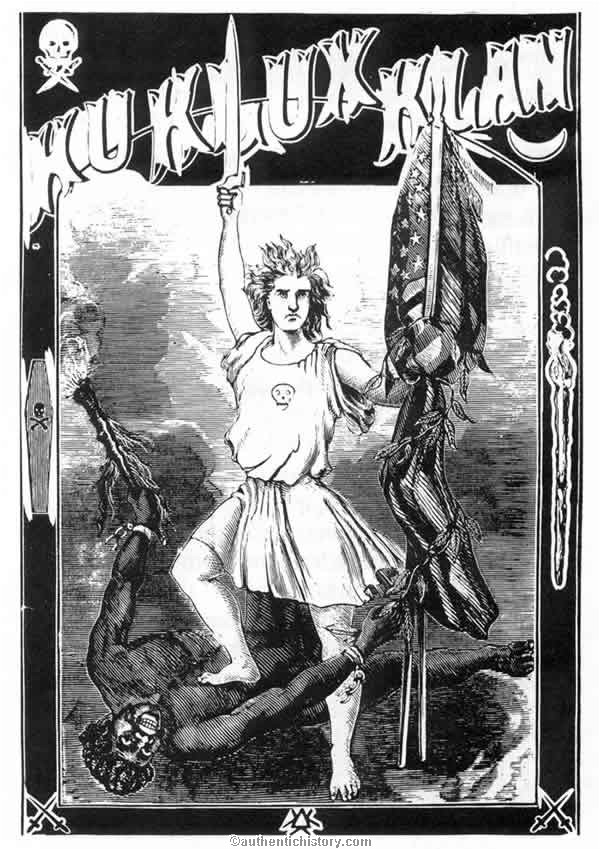
The Ku Klux Klan was born in Pulaski, Tennessee, sometime between December of 1865 and June of 1866. Although Tennessee had been divided over the slavery issue, Pulaski was in a slaveholding area. After the war, the town had been devastated by war and a major storm in 1865. In these condition, ex-Confederate soldiers found nothing to do. There were no jobs. They could have decided to help put the town back together but instead started a new club to create some amusements. They used the Greek work "Kuklos" meaning circle and added Klan to reflect their Scotch-Irish ancestry. The founders of the Ku Klux Klan loved the mysterious and occult sound of it. That, in turn, inspired their ghostly costume made of sheets and pillow cases in the beginning. Then, they added occult symbols and the conical hat looked like a witch's hat. They developed rules and mystical office titles such as Grand Cyclops, Grand Magi, Grand Turk, and Grand Dragon.
Eventually the club evolved into having fun by playing pranks against African-Americans, scalawags, and carpetbaggers. These were efforts to scare them. They pretended to be the ghosts of the Confederate dead. No one was fooled since the selected victims recognized the voices under the sheets. But, the club began to spread to neighboring areas and by the election of 1866 claimed 40,000 members and they grew bolder and more visible. Still, violence was limited until Congressional Reconstruction. African-Americans began to vote and they voted Republican. Democrats, including Klan members, blamed foreign influences for African-American activism.
The first mention of the Klan in Freedmen's Bureau documents appeared in August, 1867. The Klan was described as having fearful potential. By the spring of 1868, the KKK had become a vigilante army accused of 25 murders, 100 assaults, 4 rapes, and 4 arsons. Local authorities did nothing since Tennessee was not under federal control. By the summer of 1868, the KKK launched a reign of terror and was determined to "restore" the black man to his pre-war condition. Anyone who spoke against the Klan got a note posted on his/her door, black or white. Then, a beating, raping, pistol-whipping, or being shot followed. They particularly hated and harassed the young white women carpetbaggers who came to teach in the Freedmen's Bureau schools.
Outside the South, people tended not to take the Klan seriously. They thought it was political exaggeration. In face, the North had "KKK Fever" like a fad. They had a Ku Klux drink, a Ku Klux knife, and songs. To the North, it was all a joke. Meanwhile, the KKK grew larger. But, the presidential election turned out bad for the KKK. Ulysses S. Grant of Ohio was elected despite no political experience. But, he was anti-slavery, a critic of the Mexican War, but a moderate who focused on economic development in the South.
But Grant barely won the election. He discovered had African-Americans not voted for him, he would not have been elected. That got the attention of the Republicans. So, in his inaugural address, Grant endorsed the 15th Amendment to guarantee the vote regardless of race, color or previous condition of servitude. The ratification of the amendment was added to the requirements of southern states. The 15th Amendment went into affect in 1870.
Overall, though, Grant allowed Congress to continue its control of Reconstruction. He had other interests including the war against American Indians in the West. He also tried to buy the Dominican Republic also. But his main problem was his administration was plagued by scandals. But, when all is said and done, Grant did more for African-Americans than most Presidents. His election gave African-Americans new hope ad the 15th Amendment was a big step. For ex-Confederates, his election was a disaster ad as result no African-Americans, scalawags, or carpetbaggers were safe in the rural south. The Klan was in control. No accurate estimates of murders was documented, but in Texas, General John Reynolds reported that murders of blacks was "so common as to render it impossible to keep an accurate record of them."
Finally, in 1870-71 Congress acted by passing the so-called Ku Klux Klan Acts or Force Acts. This aimed to control the violence in the South. It banned interfering with a voter, provided more supervision of elections. To control violence, Grant sent troops into South Carolina, Mississippi, and Kentucky. Another law was passed giving African-Americans the right to sue in federal court if civil rights were infringed upon. The law also expanded presidential powers to use military force to put down disturbances and gave the President the authority to suspend the writ of Habeas Corpus. This allowed the President to ignore the order to bring a jailed person before a judge or court to find out if that person should really be in jail within an established time. So, Grant had the power to hold a suspect as long as he wished without bringing him before a judge or court. The law also compelled jurors to take an oath that they were not Klan influenced and made citizens liable for suffering to victims if they could have prevented it.
President Grant worried about the constitutionality and only fully implemented the laws in South Carolina. But Klan violence did decline. States were given leverage such as in Texas Governor Edmund Davis created a 200 man state police including 80 African-Americans. Between 1870 and 1872 they made 6,000 arrests. Violence in Texas declined. By Grant's second term (1873) other positive signs emerged. Thousands of African-Americans had left agriculture for other opportunities in the military, railroads, mining, and as cowboys. Thousands went North and West.
But, just as things got better, everything fell apart. The North was losing interest. They had their own problems with immigration, class conflict, and urban problems. Grant was losing interest, too. He even fired the Attorney General who was pro-African-American policies ad replaced him with one who pleased industrialists. Grant did sign the Civil Rights Act of 1875 that guaranteed equal accommodations but was found unconstitutional.
There were other problems besides Reconstruction. The Panic of 1873 or "Long Depression" was a 65 month economic decline begun by a banking collapse. Farmers of all races lost their land as crop prices fell. There was 20% unemployment in the cities. Half of the railroad companies went broke. Half of the iron industry shut down.
By 1874 Democrats won control of the House. To make matters worse, Grant was distracted by scandals. The Gold Scandal was revealed in 1869 when Grant's brother-in-law took a bribe to influence the President. Two millionaires tried to corner the gold market. Even the First Lady, Julia, was involved investing in gold because she knew the price would go up. They also convinced Grant to order the U.S. Treasury to hold gold creating shortages so the price of gold increased.
The Credit Mobilier scandal was exposed in 1872. Vice President Schuyler Colfax and several Senators were involved by taking bribes from railroad developers to get the government to overpay for railroad development. Then there was the Whiskey Ring of 1875 with Grant's personal secretary and oldest son with the First Lady once again. They were involved in stealing excise taxes (sin taxes). 350 people were arrested as a result. Then the Belknap scandal of 1876 revealed the Secretary of War was bribed on contracts to supply American Indians.
So with the presidential election of 1876, Republicans faced a serious challenge by Democrat Samuel Tilden of New York who was famous for exposing corruption. Grant wanted to run for a third term, but Republicans chose Rutherford B. Hayes. He was scandal-free. When it was over, they could not determine the winner. As described in Wikipedia:
"The results of the election remain among the most disputed ever, although there is no question that Samuel J. Tilden of New York outpolled Ohio's Rutherford B. Hayes in the popular vote. After a first count of votes, it was clear that Tilden had won 184 electoral votes to Hayes's 165, with 20 votes unresolved. These 20 electoral votes were in dispute in four states: in the case of Florida, Louisiana, and South Carolina, each party reported its candidate had won the state, while in Oregon one elector was declared illegal (as an "elected or appointed official") and replaced. The question of who should have been awarded these electoral votes is the source of the continued controversy concerning the results of this election. An informal deal was struck to resolve the dispute: the Compromise of 1877, which awarded all 20 electoral votes to Hayes. In return for the Democrats' acquiescence in Hayes's election, the Republicans agreed to withdraw federal troops from the South, ending Reconstruction. The Compromise effectively ceded power in the Southern states to the Democratic Redeemers."
Once Hayes was inaugurated he ended Reconstruction. African-Americans were on their own. The South became the "Solid South," all Democratic party control. They established their "redeemer" governments and rewrote the state constitutions to get rid of many of the progressive ideas. They established property requirements to vote and "grandfather clauses" that meant if you could prove your grandfather voted, you could vote. Most ex-slaves could not vote as a result.
Meanwhile, the North deserted the South and there was no visible Republican party in the South. Jim Crow laws spread. African-Americans disappeared from public offices. Most stopped voting due to the obstacles, intimidation, fear and hopelessness. African-American land ownership declined and lynching increased. To whites, it became patriotic to abuse blacks.
We will take up the aftermath of Reconstruction in History 1302. But, was Reconstruction successful? Remember the goals. Were they accomplished?